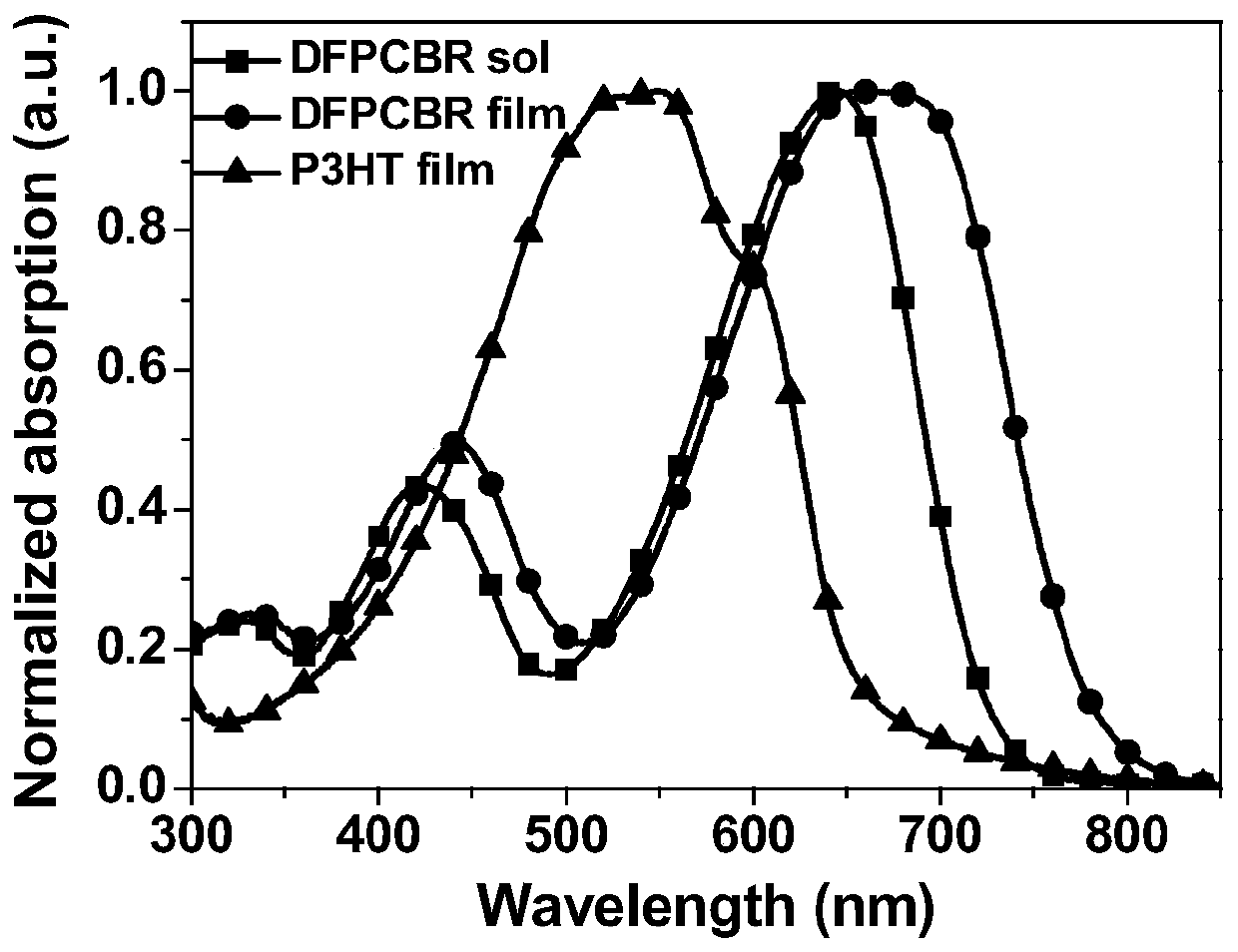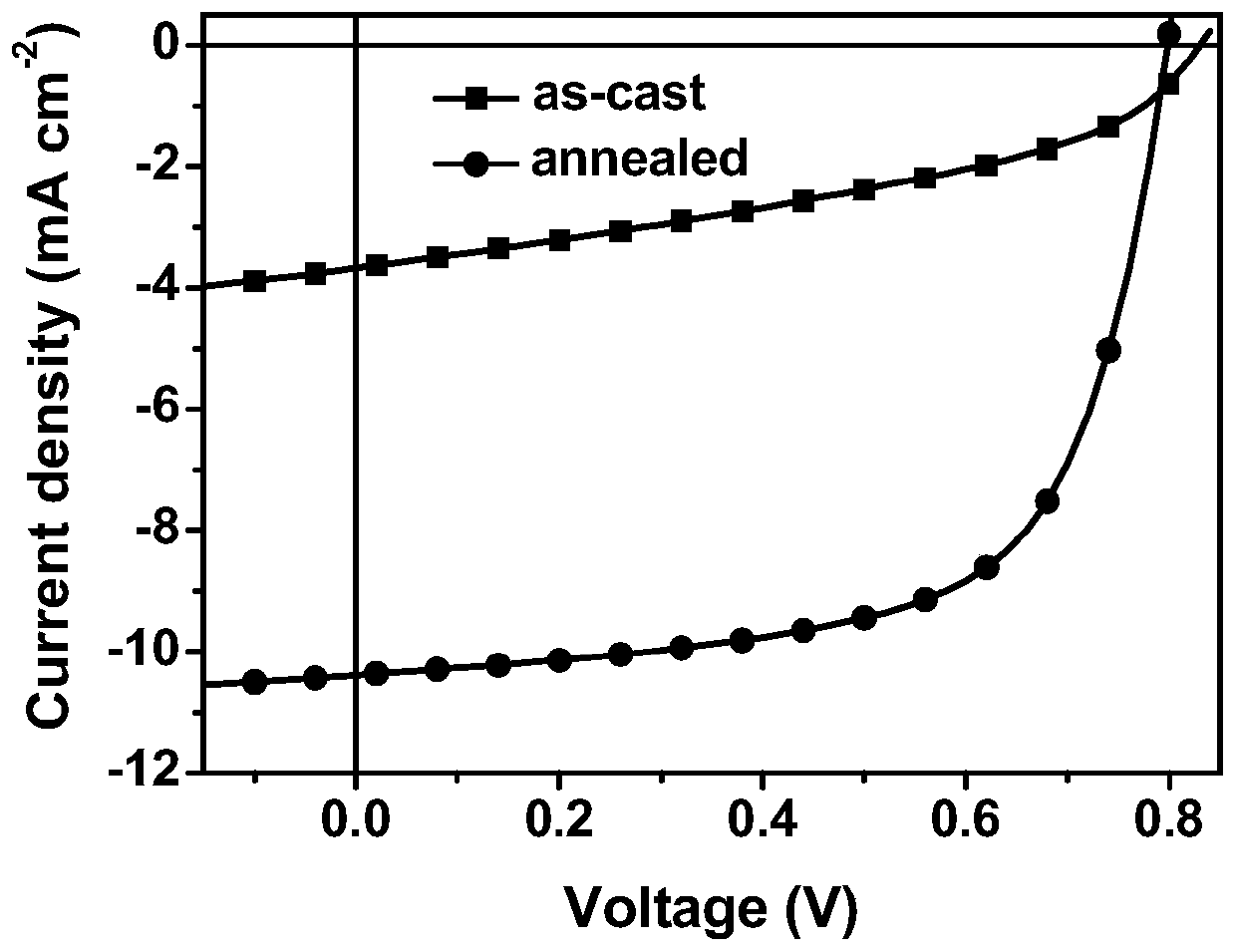A high-efficiency poly(3-hexylthiophene)-based organic solar cell
An organic solar cell, hexylthiophene technology, applied in the field of solar cells, can solve the problems of unfavorable large-scale application of organic solar cells, narrow light absorption range, difficult synthesis, etc. Effect
- Summary
- Abstract
- Description
- Claims
- Application Information
AI Technical Summary
Problems solved by technology
Method used
Image
Examples
Embodiment 1
[0017] DFPCBR is prepared from compound 1 through a three-step reaction, and the synthetic route is as follows:
[0018]
[0019] Among them, compound 1 was synthesized according to the method disclosed in Chinese patent 201710409496.1, and the specific synthesis method of DFPCBR is:
[0020] Under the protection of argon, at -78 ℃, to compound 1 (1.5g, 1.63mmol) in 30mL tetrahydrofuran (THF) solution, n-butyl lithium (n-BuLi) solution (2mL, 2.4 M, 4.8 mmol). The mixture was stirred at -78°C for 2 hours, then trimethyltin chloride solution (9.6 mL, 1M, 9.6 mmol) was added. The mixture was slowly warmed to room temperature and stirred overnight. Another 30 mL of deionized water was added to the mixture, and the mixture was extracted with dichloromethane (DCM). The combined organic phases were washed three times with water and washed with anhydrous MgSO 4 After drying, the solvent was removed by rotary evaporation to obtain compound 2 (orange oil, 1.6 g, 80%). The crude ...
Embodiment 2
[0027] The transparent conductive glass with strip-shaped ITO (cathode) etched on the surface is cleaned with cleaning agent, deionized water, acetone and isopropanol by ultrasonic oscillation, dried, and then treated with ultraviolet ozone for 15 minutes; A layer of ZnO was spin-coated at 3500 rpm for 60 seconds, and then annealed at 170° C. for 20 minutes. Then the slice was transferred to the glove box, and the methanol solution (0.4mg / mL) of PFN was spin-coated at 3000rpm for 30s. Then, the P3HT:DFPCBR chlorobenzene solution with a weight ratio of 0.8:1 and a total concentration of 20 mg / mL was spin-coated at a speed of 1300 rpm for 60 seconds to obtain an active layer with a thickness of 120 nm. Next, the active layer is annealed at 110° C. for 10 minutes. Finally, a layer of MoO with a thickness of 10 nm was evaporated with an evaporation apparatus. 3 interface layer and a 100nm thick Ag electrode (anode), resulting in an effective area of 6mm 2 organic solar cells....
Embodiment 3
[0030] The transparent conductive glass with strip-shaped ITO (cathode) etched on the surface is cleaned with cleaning agent, deionized water, acetone and isopropanol by ultrasonic oscillation, dried, and then treated with ultraviolet ozone for 15 minutes; A layer of ZnO was spin-coated at 3500 rpm for 60 seconds, and then annealed at 170° C. for 20 minutes. Then the slice was transferred to the glove box, and the methanol solution (0.4mg / mL) of PFN was spin-coated at 3000rpm for 30s. Then, the P3HT:DFPCBR chlorobenzene solution with a weight ratio of 1:1 and a total concentration of 20 mg / mL was spin-coated at a speed of 1300 rpm for 60 seconds to obtain an active layer with a thickness of 120 nm. Next, the active layer is annealed at 110° C. for 10 minutes. Finally, a layer of MoO with a thickness of 10 nm was evaporated with an evaporation apparatus. 3 interface layer and a 100nm thick Ag electrode (anode), resulting in an effective area of 6mm 2 organic solar cells. ...
PUM
| Property | Measurement | Unit |
|---|---|---|
| thickness | aaaaa | aaaaa |
Abstract
Description
Claims
Application Information
 Login to View More
Login to View More - R&D
- Intellectual Property
- Life Sciences
- Materials
- Tech Scout
- Unparalleled Data Quality
- Higher Quality Content
- 60% Fewer Hallucinations
Browse by: Latest US Patents, China's latest patents, Technical Efficacy Thesaurus, Application Domain, Technology Topic, Popular Technical Reports.
© 2025 PatSnap. All rights reserved.Legal|Privacy policy|Modern Slavery Act Transparency Statement|Sitemap|About US| Contact US: help@patsnap.com



